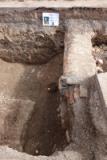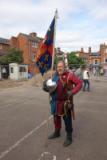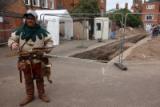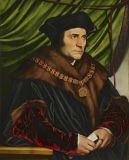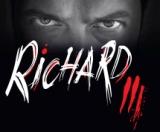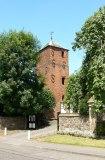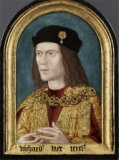Editor’s Comment: Sally Henshaw, Secretary of the Midlands East Branch of the Richard III Society, send us the following guest post on the archaeological dig in Leicester. She and Richard Smith, Chairman of the Midlands East Branch, had the opportunity of a private tour of the site.
Richard Smith and I went to see the dig yesterday and Philippa Langley of the Richard III Society showed us round. We also had a few words with Richard Buckley, lead archaeologist of the project, who we know, as he has given talks to our branch on several occasions.
I took photographs of the first and second trenches as Philippa explained what things were (see below).
Unfortunately we were not allowed to see the third trench as they are working on that one at present. They have found a medieval coin, but as yet have not been able to date it. They have also found pieces of medieval stained glass and brightly painted floor tiles. They hope the choir of the church (where Richard was buried) is located in the car park where they are now digging and not under the building (although it may be possible to dig a trench if it is) It would be awful to have come so far only to find that the part we really need to get at is under a building.
 Trench 2: internal cloister walkway showing the herring bone pattern (© Sally Henshaw)
Trench 2: internal cloister walkway showing the herring bone pattern (© Sally Henshaw)
 Trench 2: The white part is a rounded step which they are calling the Leicester Step at present, as no one has seen anything quite like it before. (© Sally Henshaw)
Trench 2: The white part is a rounded step which they are calling the Leicester Step at present, as no one has seen anything quite like it before. (© Sally Henshaw)
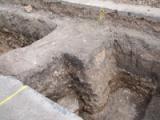 Trench 1: showing where the all cuts across (© Sally Henshaw)
Trench 1: showing where the all cuts across (© Sally Henshaw)
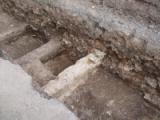 Trench 1: the white area is a bench they found where the monks would have sat in the chapter house (© Sally Henshaw)
Trench 1: the white area is a bench they found where the monks would have sat in the chapter house (© Sally Henshaw)
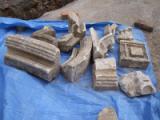
Window tracery (© Sally Henshaw)
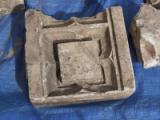
Frieze on a choir stall, early perpendicular (?) (© Sally Henshaw)
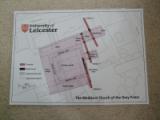 Plan of the dig (© Sally Henshaw)
Plan of the dig (© Sally Henshaw)
Tags: Archaeology, Leicester, Leicester Greyfriars Dig, Richard III
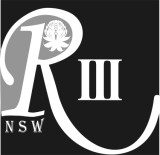 The September 2012 issue of the Ricardian Bulletin has just arrived in my letter-box. As always it promises to be an interesting read. The NSW branch is well represented with the invitation to the Australasian Convention in 2013, which will be hosted by our branch, an article on Dorothea being able to attend the Bulletin Committee meeting in London and the sad news of Harold passing.
The September 2012 issue of the Ricardian Bulletin has just arrived in my letter-box. As always it promises to be an interesting read. The NSW branch is well represented with the invitation to the Australasian Convention in 2013, which will be hosted by our branch, an article on Dorothea being able to attend the Bulletin Committee meeting in London and the sad news of Harold passing.